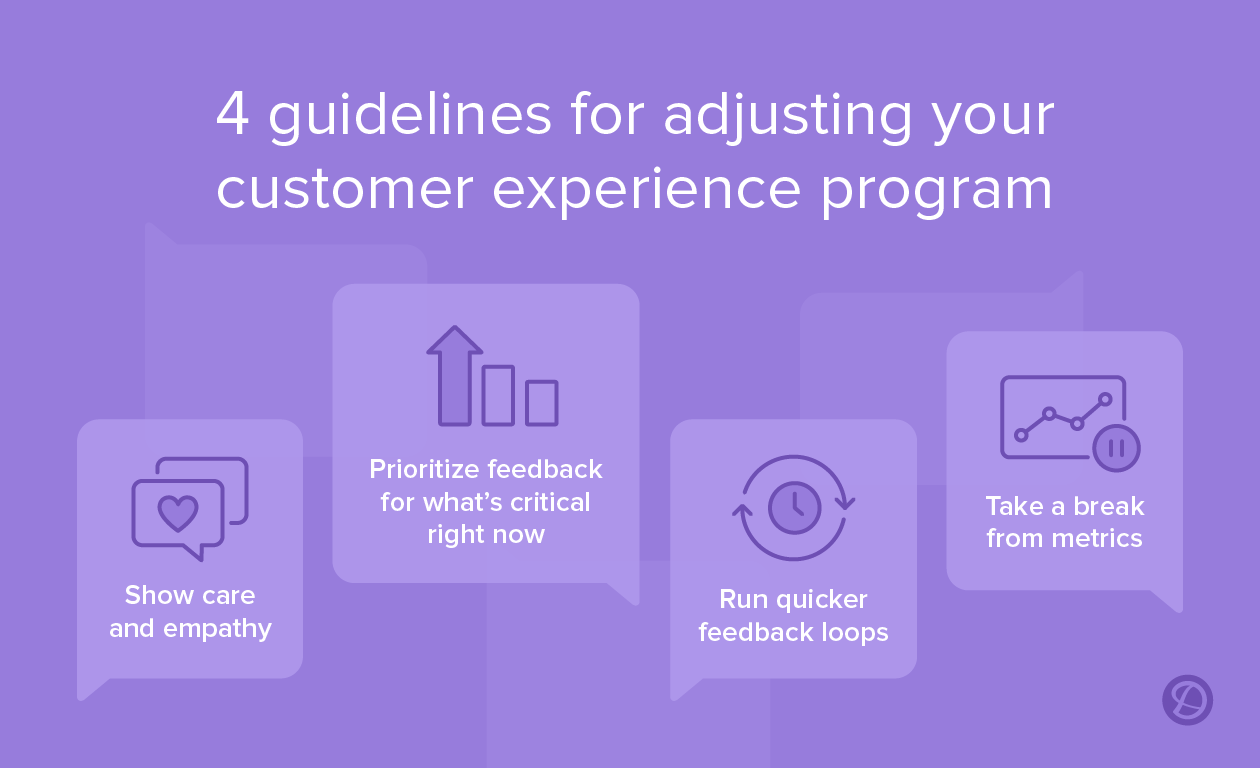In our previous post on improving the customer experience, we went over how streamlining support and onboarding processes can help you retain customers during difficult times.
In this post, we’ll focus on how to adjust your customer experience program to be appropriate for the current situation. We’ll also speak to the importance of monitoring sentiment as you transition your company into uncharted territory.
Let’s dive into how to approach your customer experience program when everyone’s day-to-day has been so heavily disrupted.
4 guidelines for adjusting your customer experience program during market disruption
Many of our customers have asked whether it’s still appropriate to ask for feedback and how to go about it. The short answer is that it is okay to continue asking for feedback – keep communication lines open. The one caveat is that it should be done with your customers’ and employees’ best interest in mind.
Here are four guidelines, adapted from this informative guide on how to handle your customer experience program during sensitive times.

1. Show care and empathy
When collecting feedback, revise your customer and employee communications to make it clear that you’re asking out of a place of care. Stay empathetic, and recognize that people have less patience for any messaging that comes off as self-serving. Convey that what you’re doing is for their benefit.
2. Prioritize feedback for what’s critical right now
Your customer experience program was probably set up under “business as usual” circumstances, but there’s nothing usual about what’s going on right now.
Pivot your program towards capturing how your customers and employees are doing in the moment. Only gather feedback on what’s relevant and helpful for your audience.
“Focus less on what drives promoters in the long-term, and more on what changes you need to make to keep customers happy in the near-term.”
— Bruce Temkin, Qualtrics XM Institute
What to consider when adjusting your program:
- Reevaluate your normal relational survey questions and cadence, and shift away from measuring overall business sentiment to what your loyalty drivers are right now.
- Focus on pulse surveys and transactional surveys to monitor real-time sentiment on active programs and new initiatives.
- Ask fewer questions, and use more open-ended questions such as, “How can we help?”
- Tie in front-line feedback from support team conversations. Surveys aren’t your only route for understanding what your customers think and feel.
The basic principle that data is only as useful as your capacity to act on it still holds true. Prioritize collecting feedback only on what’s critical and what you can close the loop on.
3. Run quicker feedback loops
Circumstances are changing on a daily basis, and your business strategy is likely evolving to match. Monitoring how these changes are impacting customers and employees is only the first step.
Responding to that feedback in real time is what’s most important. As mentioned earlier, there’s no point collecting feedback right now if you’re unable to do anything with it.
Give daily or weekly updates on what you’re hearing from customers, and the actions being taken to address those concerns. Reinforce closed-loop processes so that your entire team is mobilized to respond and stays flexible.
4. Take a break from metrics
External circumstances impact how people feel and react, and that may color their numerical ratings for the duration of this period. Asking for feedback for the sake of the numbers would be counterproductive.
Focus instead on how your customers answer your open-ended survey questions. What are they saying they need? For any new initiatives launched, analyze the resulting feedback for actionable insights.
In short, if you don’t have a customer-focused reason to reach out or the capacity to act on that feedback, leave it be.
With the mindset that everything you do is for your customers and employees, you should be able to continue improving your customer experience for increased retention.
To pick up where we left off in the last post, let’s continue going through examples of how customer feedback can help you identify areas to improve the customer experience, even during times of instability.
Make product improvements and flag issues as you enter new territory
If you’re able, launching a helpful new feature is a much-needed positive development during these times. In fact, doing so demonstrates that A) you’re sticking around for the long haul; and B) your product will continue to be relevant to their needs.
Uncertain times could also call for a departure from normal processes. Consider releasing a beta version of a feature earlier than you usually would to help customers through the current situation.
As many businesses and institutions go full-remote, monitoring sentiment throughout the transition is vital for iterative improvements. To speak to the guidelines we went through earlier, asking for feedback on these new initiatives is entirely appropriate. Focus on what’s critical, and stay connected to your audience to remain effective for the duration and beyond.
How a home exercise equipment and fitness class startup uses feedback to flag improvements for product entries in a new market
This exercise equipment startup implemented Delighted to aggregate and analyze customer feedback associated with the roll-out of a completely new product line. Since this debut marked new territory, their team didn’t have a complete picture of what key satisfaction drivers would be.
Feedback bridged the gap.
Using Delighted NPS to monitor satisfaction, they were able to quickly flag key issues that were not even on the radar for their current line of products. For example, they saw a -30 NPS related to open-ended comments that referenced the noise/sound of the new product, saying that it was too loud.
They were able to relay this feedback to their production team, addressing issues with various equipment components and other functional elements (including better installation guidance) to minimize noise.
The result? Mentions of “loud” and “noise” were almost completely eliminated, and when mentioned, were associated with a net positive NPS versus the -30 NPS they saw previously.
As companies continue to enter a new normal, collecting feedback on the transition is invaluable for remaining laser-focused on customer preferences.
Clarify your marketing and sales messaging
We mentioned earlier how you should revise calls for feedback to emphasize care, but the same goes for all of your other ongoing programs. Examples would be email promotions, sales presentations, and social media marketing. Go through your messaging and make sure it is appropriate for the circumstances.
If call volume is down right now, this is also a good time to reinvest in your marketing materials:
- Scrub your website
- Clean up your sales decks
- Drive your differentiators home
Ask your support team to proof the materials – they’ll be able to point out what might get misinterpreted.
Align your messaging with what the customer can expect and achieve, so it’s easier for your success team to prove value when renewal conversations arise.
How a B2B2C Delighted customer turned sentiment around by improving accuracy
One of our customers facilitates on-demand restaurant delivery, which is especially relevant now as demand increases while restaurants shutter down to weather the storm.
This on-demand delivery company is not only responsible for the accuracy of their own content, but needs to enable their merchants as well. Their multilayer use case shows how you can use customer feedback to identify a need, monitor the impact, and iterate for an improved experience.
Based on a convergence of consumer and merchant feedback around menu accuracy, they introduced a new portal for merchants to update menus rapidly, close menus across separate locations, and make other critical changes.
They then introduced a new CX touchpoint with Delighted, using customer satisfaction software for menu updates amongst merchants to fine-tune the portal and address key performance issues (ex. loading times, etc.)
Though they saw an initially low CSAT as the new portal was introduced, they were able to rapidly address those concerns with real-time Delighted feedback. Overall, they’ve seen a complete reversal of customer sentiment around menu accuracy, with both consumer and merchant Net Promoter Scores increasing by multiple points month over month for menu-related feedback.
Ensure your priorities are aligned with customer needs
Instead of cutting back on customer experience platform usage, many of our customers are doubling down. A customer experience platform is invaluable for matching priorities to demand.
Sometimes, the traditional metrics for gauging success can be misleading, especially during this time. Even revenue numbers are not immune. Feedback supplements metrics, and communicates sentiment throughout your organization.
“What we couldn’t see initially was that users disliked the thing that they were spending money on, which means they were never going to come back. With Delighted, we opened a torrent of user feedback, which we prioritize and act on to create a much more user-friendly site. All of these things have helped us build and grow a loyal audience.”
— Warren St. John, President of Patch
Find out more about how Patch uses Delighted to improve user flows, refine messaging, and make tough decisions about the product roadmap in this case study.
Proactively improve your customer experience
With a light-touch customer experience platform like Delighted in place (we offer a robust free plan as well), you’ll be able to surface what your company needs to pay attention to during this difficult time.
Our expert Customer Concierge team can help you strategize adjustments to your customer experience program. Get started with our free experience management software today.







